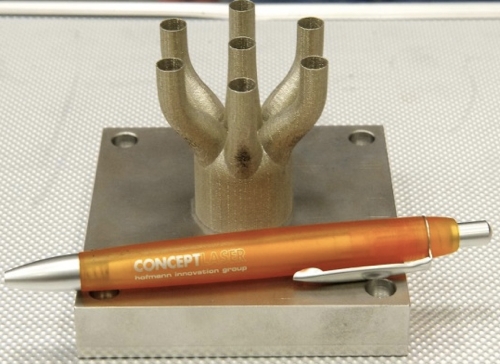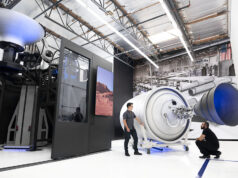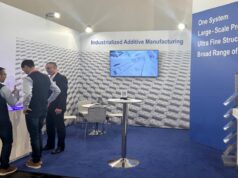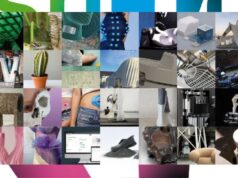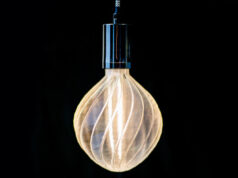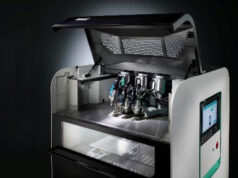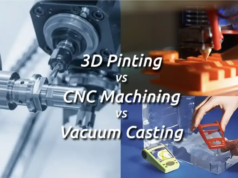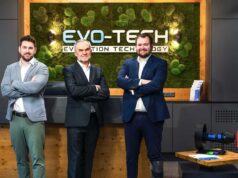Die Weltraumorganisation NASA vermeldet einen weiteren Einsatz von 3D-Drucktechnologie. Mithilfe von “Selektives Laserschmelzen” möchte die Organisation Raketenteile erstellen.
15.11.12 – Beim “Selektive Laser Sintering” wird Metallpulver mithilfe eines hochleistungs-Lasers zu einem 3-Dimensionalen Objekt verschmolzen. Diese Form von Produktion funktioniert mit unterschiedlichen Metallen und wird nach dem 3D-Druck in speziellen Öfen oftmals nach verschmolzen. Dadurch lassen sich äußerst komplexe Strukturen erstellen, die über eine Stabilität verfügen als wären sie aus einem Guss. Zusätzlich fällt bei diesem Verfahren nahezu kein Abfall an, da nur das Material verwendet wird, das unmittelbar in das Produkt einfließt. Die Technologie wird bereits bei der Produktion von Flugzeugen und Tubinen verwendet.
Im Zuge des Baus der neuen Trägerraketenfamilie “Space Launch System” (SLS), möchte nun auch NASA diese Technologie verwenden. Die Technologie soll noch dieses Jahr im neuen J-2X-Triebwerk getestet werden und im optimalen Fall 2017 beim ersten SLS-Testflug Anwendung finden.
Die Weltraumorganisation NASA hat scheinbar gefallen an der 3D-Drucktechnologie gefunden. Neben Contour Crafting am Mond und NASA´s neuer Rover forscht man auch an EBF3 einem 3D-Druckverfahren für den Weltraum.
(c) Picture & Link: NASA
Update: 12.07.13 – Additiv hergestellter “Rocket Engine Injector” erfolgreich getestet
NASA’s Glenn Research Center in Cleveland hat nun einen 3D-gedruckten Rocket Engine Injector erfolgreich getestet. Während die Produktion eines solchen Teils bislang ein Jahr benötigte, konnte es mittels Additive Manufacturing in nur 4 Monaten produziert werden. Zusätzlich konnten 70% der Kosten gespart werden.
“Rocket engine components are complex machined pieces that require significant labor and time to produce. The injector is one of the most expensive components of an engine,” said Tyler Hickman, who led the testing at Glenn.
Aerojet Rocketdyne’s additive manufacturing program manager, Jeff Haynes, said the injector represents a significant advancement in application of additive manufacturing, most often used to make simple brackets and other less critical hardware. “The injector is the heart of a rocket engine and represents a large portion of the resulting cost of these systems. Today, we have the results of a fully additive manufactured rocket injector with a demonstration in a relevant environment.” he said.
“Hot fire testing the injector as part of a rocket engine is a significant accomplishment in maturing additive manufacturing for use in rocket engines,” said Carol Tolbert, manager of the Manufacturing Innovation Project at Glenn. “These successful tests let us know that we are ready to move on to demonstrate the feasibility of developing full-size, additively manufactured parts.”
via NASA
Update: 28.08.2013 – 3D gedruckter Engine Injector erzeugt Rekordschub
Bei einem weiteren Test des Engine Injectors aus dem 3D-Drucker, wurde laut Pressemeldung der NASA eine Rekord Schubkraft von 20.000 “pounds of thrust” erzeugt.
The largest 3-D printed rocket engine component NASA ever has tested blazed to life Aug. 22 during an engine firing that generated a record 20,000 pounds of thrust.
This test is a milestone for one of many important advances the agency is making to reduce the cost of space hardware. Innovations like additive manufacturing, or 3-D printing, foster new and more cost-effective capabilities in the U.S. space industry.
The component tested during the engine firing, an injector, delivers propellants to power an engine and provides the thrust necessary to send rockets to space. During the injector test, liquid oxygen and gaseous hydrogen passed through the component into a combustion chamber and produced 10 times more thrust than any injector previously fabricated using 3-D printing.
“This successful test of a 3-D printed rocket injector brings NASA significantly closer to proving this innovative technology can be used to reduce the cost of flight hardware,” said Chris Singer, director of the Engineering Directorate at NASA’s Marshall Space Flight Center in Huntsville Ala.
The component was manufactured using selective laser melting. This method built up layers of nickel-chromium alloy powder to make the complex, subscale injector with its 28 elements for channeling and mixing propellants. The part was similar in size to injectors that power small rocket engines. It was similar in design to injectors for large engines, such as the RS-25 engine that will power NASA’s Space Launch System (SLS) rocket for deep space human missions to an asteroid and Mars.
“This entire effort helped us learn what it takes to build larger 3-D parts — from design, to manufacturing, to testing,” said Greg Barnett, lead engineer for the project. “This technology can be applied to any of SLS’s engines, or to rocket components being built by private industry.”
One of the keys to reducing the cost of rocket parts is minimizing the number of components. This injector had only two parts, whereas a similar injector tested earlier had 115 parts. Fewer parts require less assembly effort, which means complex parts made with 3-D printing have the potential for significant cost savings.
“We took the design of an existing injector that we already tested and modified the design so the injector could be made with a 3-D printer,” explained Brad Bullard, the propulsion engineer responsible for the injector design. “We will be able to directly compare test data for both the traditionally assembled injector and the 3-D printed injector to see if there’s any difference in performance.”
Early data from the test, conducted at pressures up to 1,400 pounds per square inch in a vacuum and at almost 6,000 degrees Fahrenheit, indicate the injector worked flawlessly. In the days to come, engineers will perform computer scans and other inspections to scrutinize the component more closely.
The injector was made by Directed Manufacturing Inc., of Austin, Texas, but NASA owns the injector design. NASA will make the test and materials data available to all U.S. companies through the Materials and Processes Information System database managed by Marshall’s materials and processes laboratory.
NASA seeks to advance technologies such as 3-D printing to make every aspect of space exploration more cost-effective. This test builds on prior hot-fire tests conducted with smaller injectors at Marshall and at NASA’s Glenn Research Center in Cleveland. Marshall engineers recently completed tests with Made in Space, a Moffett Field, Calif., company working with NASA to develop and test a 3-D printer that will soon print tools for the crew of the International Space Station. NASA is even exploring the possibility of printing food for long-duration space missions.
via NASA


